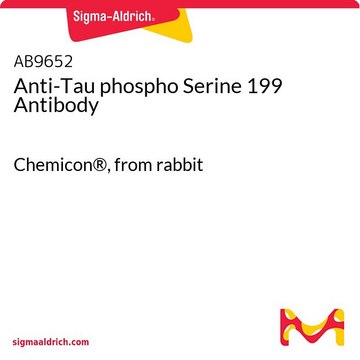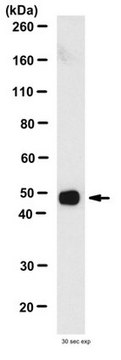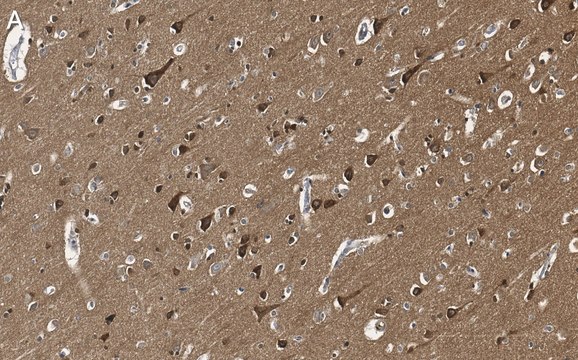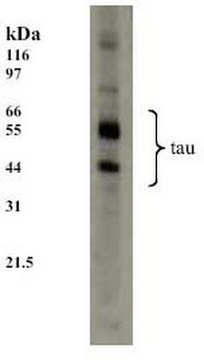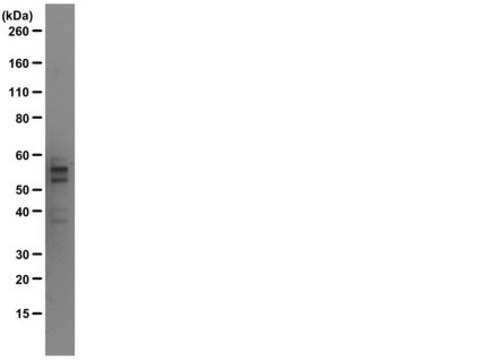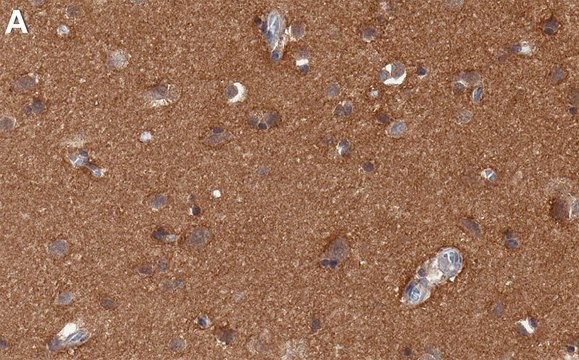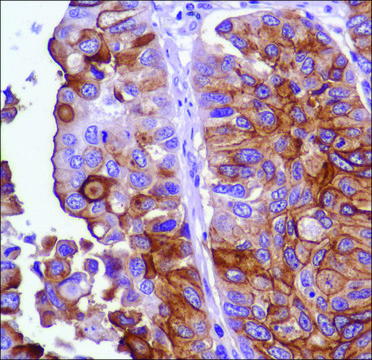一般描述
We are committed to bringing you greener alternative products, which adhere to one or more of The 12 Principles of Green Chemistry.This antibody is Preservative-free, produced without the harm or sacrifice of animals and exceptionally stable to allow for ambient shipping and storage if needed and thus aligns with "Waste Prevention", "Designing Safer Chemicals" and "Design for Energy Efficiency".
Click here for more information.
ZooMAb® antibodies represent an entirely new generation of recombinant monoclonal antibodies.Each ZooMAb® antibody is manufactured using our proprietary recombinant expression system, purified to homogeneity, and precisely dispensed to produce robust and highly reproducible lot-to-lot consistency. Only top-performing clones are released for use by researchers. Each antibody is validated for high specificity and affinity across multiple applications, including its most commonly used application. ZooMAb® antibodies are reliably available and ready to ship when you need them.
特异性
Clone Tau-5 is a ZooMAb® Mouse recombinant monoclonal antibody that specifically detects Tau protein. It targets an epitope within 32 amino acids from the internal region.
免疫原
Full-length purified Bovine Tau protein.
应用
Quality Control Testing
Evaluated by Western Blotting in Human brain tissue lysate.
Western Blotting Analysis: A 1:1,000 dilution of this antibody detected Tau protein in Human brain tissue lysate.
Tested applications
Western Blotting Analysis: A 1:1,000 dilution from a representative lot detected Tau protein in Mouse brain tissue lysate.
Immunocytochemistry Analysis (ICC): A 1:100 dilution from a representative lot detected Tau protein in rat oligodendrocytes.
Enzyme Immunoassay Analysis (ELISA): Serial dilutions from a representative lot detected recombinant Human Tau protein.
Affinity Binding Assay: A representative lot of this antibody bound recombinant Human Tau protein with a KD of 1.2 x 10-6 in an affinity binding assay.
Immunohistochemistry (Paraffin) Analysis: A 1:5,000 dilution from a representative lot detected Tau protein in human cerebral cortex tissue sections.
Note: Actual optimal working dilutions must be determined by end user as specimens, and experimental conditions may vary with the end user
Evaluated by Western Blotting in Human brain tissue lysate.
Western Blotting Analysis: A 1:1,000 dilution of this antibody detected Tau protein in Human brain tissue lysate.
目标描述
Microtubule-associated protein tau (UniProt: P29172; also known as Neurofibrillary tangle protein, Paired helical filament-tau, PHF-tau) is encoded by the MAPT (also known as Tau) gene (Gene ID: 281296) in bovine species. Microtubule-associated protein tau that is expressed in neurons is mostly found in axons, in the cytosol, and in association with plasma membrane components. Twenty isoforms of bovine Tau have been described that are generated by alternative splicing. Tau proteins promote microtubule assembly and stability and may also be involved in the establishment and maintenance of neuronal polarity. The C-terminus binds axonal microtubules while the N-terminus binds neural plasma membrane components, thus serving as a linker protein between both. The short isoforms are reported to allow plasticity of the cytoskeleton whereas the longer isoforms may preferentially play a role in its stabilization. In Alzheimer disease (AD), the neuronal cytoskeleton in the brain is progressively disrupted and replaced by tangles of paired helical filaments (PHF) and straight filaments, mainly composed of hyperphosphorylated forms of Tau. In AD brain Tau accumulates in both the somatodendritic and axonal regions of neurons and in the soma as neurofibrillary tangles (NFTs). Tau oligomers are reported to be neurotoxic when applied extracellularly to cultured neuronal cells and can induce neurodegeneration and synaptic and mitochondrial dysfunction in vivo. It has been reported that most of the C-terminus of Tau in PHFs can be cleaved by trypsin, however the TauC4 region is highly resistant to trypsin action. This ZooMAbZooMAb® recombinant monoclonal antibody, generated by our propriety technology, offers significantly enhanced specificity, affinity, reproducibility, and stability over conventional monoclonals. (Ref.: Taniguchi Watanabe, S., et al. (2016). Acta Neuropathol. 131(2); 267-280; Ando K., et al. (2010). Biochem. Soc. Trans. 38(4); 1001-1005).
外形
Purified recombinant mouse monoclonal antibody IgG, lyophilized in PBS, 5% Trehalose, normal appearance a coarse or translucent resin. The PBS/trehalose components in the ZooMAb formulation can have the appearance of a semi-solid (bead like gel) after lyophilization. This is a normal phenomenon. Please follow the recommended reconstitution procedure in the data sheet to dissolve the semi-solid, bead-like, gel-appearing material. The resulting antibody solution is completely stable and functional as proven by full functional testing. Contains no biocide or preservatives, such as azide, or any animal by-products. Larger pack sizes provided as multiples of 25 μL.
重悬
300 μg/mL after reconstitution at 25 μL per vial. Please refer to guidance on suggested starting dilutions and/or titers per application and sample type.
储存及稳定性
Recommend storage of lyophilized product at 2-8°C; Before reconstitution, micro-centrifuge vials briefly to spin down material to bottom of the vial; Reconstitute each vial by adding 25 μL of filtered lab grade water or PBS; Reconstituted antibodies can be stored at 2-8°C, or -20°C for long term storage. Avoid repeated freeze-thaws.
法律信息
ZooMAb is a registered trademark of Merck KGaA, Darmstadt, Germany
免责声明
Unless otherwise stated in our catalog or other company documentation accompanying the product(s), our products are intended for research use only and are not to be used for any other purpose, which includes but is not limited to, unauthorized commercial uses, in vitro diagnostic uses, ex vivo or in vivo therapeutic uses or any type of consumption or application to humans or animals.

